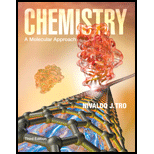
Masteringchemistry with Pearson Etext -- Standalone Access Card -- For Chemistry
3rd Edition
ISBN: 9780321806383
Author: Nivaldo J. Tro
Publisher: PEARSON
expand_more
expand_more
format_list_bulleted
Concept explainers
Question
Chapter 10, Problem 81E
Interpretation Introduction
Interpretation: The bond order of CO by making a sketch of the lowest energy bonding molecular orbital and using the energy order of O2
Concept Introduction:
Carbon has four valence electrons and oxygen has six. Thus, the total valence electrons = 10.

Expert Solution & Answer
Want to see the full answer?
Check out a sample textbook solution
Students have asked these similar questions
10.
Stereochemistry. Assign R/S stereochemistry for the chiral center indicated on the
following compound. In order to recieve full credit, you MUST SHOW YOUR WORK!
H₂N
CI
OH
CI
カー
11. () Stereochemistry. Draw all possible stereoisomers of the following compound. Assign
R/S configurations for all stereoisomers and indicate the relationship between each as
enantiomer, diastereomer, or meso.
NH2
H
HNH,
-18
b)
8.
Indicate whether the following carbocation rearrangements are likely to occur
Please explain your rational using 10 words or less
not likely to occur
• The double bond is still in the
Same position
+
Likely
to oc
occur
WHY?
-3
H3C
Brave
Chair Conformers. Draw the chair conformer of the following substituted
cyclohexane. Peform a RING FLIP and indicate the most stable
conformation and briefly explain why using 20 words or less.
CI
2
-cobs ??
MUST INDICATE H -2
-2
Br
EQ
Cl
OR
AT
Br
H&
most stable
WHY?
- 4
CH
12
Conformational Analysis. Draw all 6 conformers (one above each letter) of the
compound below looking down the indicated bond. Write the letter of the
conformer with the HIGHEST and LOWEST in energies on the lines provided.
NOTE: Conformer A MUST be the specific conformer of the structure as drawn below
-4 NOT
HOH
OH
3
Conformer A:
Br
OH
A
Samo
Br H
04
Br
H
H3
CH₂
H
anti
stagere
Br CH
clipsed
H
Brott
H
IV
H
MISSING 2
-2
B
C
D
E
F
X
6
Conformer with HIGHEST ENERGY:
13. (1
structure
LOWEST ENERGY:
Nomenclature. a) Give the systematic (IUPAC) name structure. b) Draw the
corresponding to this name. HINT: Do not forget to indicate stereochemistry
when applicable.
a)
८८
2
"Br
{t༐B,gt)-bemn€-nehpརི་ཚ༐lnoa
Parent name (noname)
4 Bromo
Sub = 2-methylethyl-4 Bromo nonane
b) (3R,4S)-3-chloro-4-ethyl-2,7-dimethyloctane
# -2
-2
Chapter 10 Solutions
Masteringchemistry with Pearson Etext -- Standalone Access Card -- For Chemistry
Ch. 10 - Prob. 1SAQCh. 10 - Prob. 2SAQCh. 10 - Prob. 3SAQCh. 10 - Prob. 4SAQCh. 10 - Prob. 5SAQCh. 10 - Prob. 6SAQCh. 10 - Prob. 7SAQCh. 10 - Prob. 8SAQCh. 10 - Prob. 9SAQCh. 10 - Q10. Apply molecular orbital theory to predict...
Ch. 10 - Q11. Apply molecular orbital theory to determine...Ch. 10 - Q12. Which hybridization scheme occurs about...Ch. 10 - Q13. Which molecular geometry results when a...Ch. 10 - Prob. 14SAQCh. 10 - Prob. 15SAQCh. 10 - 1. Why is molecular geometry important? Cite some...Ch. 10 - 2. According to VSEPR theory, what determines the...Ch. 10 - 3. Name and sketch the five basic electron...Ch. 10 - 4. Explain the difference between electron...Ch. 10 - 5. Give the correct electron and molecular...Ch. 10 - 6. How do you apply VSEPR theory to predict the...Ch. 10 - Prob. 7ECh. 10 - Prob. 8ECh. 10 - 9. In valence bond theory, what determines the...Ch. 10 - 10. In valence bond theory, the interaction energy...Ch. 10 - Prob. 11ECh. 10 - Prob. 12ECh. 10 - 13. How is the number of hybrid orbitals related...Ch. 10 - Prob. 14ECh. 10 - Prob. 15ECh. 10 - 16. Name the hybridization scheme that corresponds...Ch. 10 - Prob. 17ECh. 10 - Prob. 18ECh. 10 - 19. What is a bonding molecular orbital?
Ch. 10 - 20. What is an antibonding molecular orbital?
Ch. 10 - 21. What is the role of wave interference in...Ch. 10 - Prob. 22ECh. 10 - 23. How is the number of molecular orbitals...Ch. 10 - 24. Sketch each molecular orbital.
a. σ2s
b.
c....Ch. 10 - Prob. 25ECh. 10 - Prob. 26ECh. 10 - Prob. 27ECh. 10 - Prob. 28ECh. 10 - Prob. 29ECh. 10 - 30. Write a short paragraph describing chemical...Ch. 10 - 31. A molecule with the formula AB3 has a trigonal...Ch. 10 - 32. A molecule with the formula AB3 has a trigonal...Ch. 10 - 33. For each molecular geometry, list the number...Ch. 10 - Prob. 34ECh. 10 - 35. Determine the electron geometry, molecular...Ch. 10 - Prob. 36ECh. 10 - 37. Which species has the smaller bond angle, H3O...Ch. 10 - Prob. 38ECh. 10 - 39. Determine the molecular geometry and sketch...Ch. 10 - Prob. 40ECh. 10 - Prob. 41ECh. 10 - Determine the molecular geometry about each...Ch. 10 - 43. Each ball-and-stick model shows the electron...Ch. 10 - 44. Each ball-and-stick model shows the electron...Ch. 10 - 45. Determine the geometry about each interior...Ch. 10 - Prob. 46ECh. 10 - Prob. 47ECh. 10 - Prob. 48ECh. 10 - Prob. 49ECh. 10 - Prob. 50ECh. 10 - Determine whether each molecule is polar or...Ch. 10 - Prob. 52ECh. 10 - 53. The valence electron configurations of several...Ch. 10 - 54. The valence electron configurations of several...Ch. 10 - 55. Write orbital diagrams (boxes with arrows in...Ch. 10 - Prob. 56ECh. 10 - 57. Write orbital diagrams (boxes with arrows in...Ch. 10 - Prob. 58ECh. 10 - 59. Which hybridization scheme allows the...Ch. 10 - Prob. 60ECh. 10 - Prob. 61ECh. 10 - 62. Write a hybridization and bonding scheme for...Ch. 10 - Prob. 63ECh. 10 - Prob. 64ECh. 10 - 65. Write a hybridization and bonding scheme for...Ch. 10 - Write a hybridization and bonding scheme for each...Ch. 10 - 67. Consider the structure of the amino acid...Ch. 10 - 68. Consider the structure of the amino acid...Ch. 10 - 69. Sketch the bonding molecular orbital that...Ch. 10 - Prob. 70ECh. 10 - 71. Draw an MO energy diagram and predict the bond...Ch. 10 - Prob. 72ECh. 10 - Prob. 73ECh. 10 - Prob. 74ECh. 10 - Prob. 75ECh. 10 - 76. Using the molecular orbital energy ordering...Ch. 10 - 77. Use molecular orbital theory to predict if...Ch. 10 - 78. Use molecular orbital theory to predict if...Ch. 10 - Prob. 79ECh. 10 - Prob. 80ECh. 10 - 81. Draw an MO energy diagram for CO. (Use the...Ch. 10 - Prob. 82ECh. 10 - 83. For each compound, draw the Lewis structure,...Ch. 10 - 84. For each compound, draw the Lewis structure,...Ch. 10 - 85. Amino acids are biological compounds that link...Ch. 10 - 86. The genetic code is based on four different...Ch. 10 - 87. The structure of caffeine, present in coffee...Ch. 10 - 88. The structure of acetylsalicylic acid...Ch. 10 - 89. Most vitamins can be classified as either fat...Ch. 10 - 90. Water does not easily remove grease from...Ch. 10 - Prob. 91ECh. 10 - Prob. 92ECh. 10 - 93. Bromine can form compounds or ions with any...Ch. 10 - 94. The compound C3H4 has two double bonds....Ch. 10 - Prob. 95ECh. 10 - Prob. 96ECh. 10 - Prob. 97ECh. 10 - 98. Indicate which orbitals overlap to form the s...Ch. 10 - 99. In VSEPR theory, which uses the Lewis model to...Ch. 10 - 100. The results of a molecular orbital...Ch. 10 - 101. The results of a molecular orbital...Ch. 10 - Prob. 102ECh. 10 - Prob. 103ECh. 10 - Prob. 104ECh. 10 - Prob. 105ECh. 10 - 106. Neither the VSEPR model nor the hybridization...Ch. 10 - 107. Draw the Lewis structure for acetamide...Ch. 10 - Prob. 108ECh. 10 - 109. Which statement best captures the fundamental...Ch. 10 - 110. Suppose that a molecule has four bonding...Ch. 10 - 111. How does each of the three major bonding...Ch. 10 - Prob. 112E
Knowledge Booster
Learn more about
Need a deep-dive on the concept behind this application? Look no further. Learn more about this topic, chemistry and related others by exploring similar questions and additional content below.Similar questions
- in the scope of the SCH4U course! please show all steps as im still learning how to format my answers in the format given, thank you!arrow_forwardhelp me solve this HWarrow_forwardMolecules of the form AH2 can exist in two potential geometries: linear or bent. Construct molecular orbital diagrams for linear and bent CH2. Identify the relevant point group, include all of the appropriate symmetry labels and pictures, and fill in the electrons. Which geometry would you predict to be more stable, and why? (Please draw out the diagram and explain)arrow_forward
- Indicate the variation in conductivity with concentration in solutions of strong electrolytes and weak electrolytes.arrow_forwardThe molar conductivity of a very dilute solution of NaCl has been determined. If it is diluted to one-fourth of the initial concentration, qualitatively explain how the molar conductivity of the new solution will compare with the first.arrow_forwardWhat does the phrase mean, if instead of 1 Faraday of electricity, Q coulombs (Q/F Faradays) pass through?arrow_forward
- What characteristics should an interface that forms an electrode have?arrow_forwardFor a weak acid AcH, calculate the dissociated fraction (alpha), if its concentration is 1.540 mol L-1 and the concentration [H+] is 5.01x10-4 mol L-1.arrow_forwardIf the molar conductivity at infinite dilution of HAC is A0 = 390.5 S cm² mol¹. Calculate the Arrhenius conductivity of a 9.3% by weight solution of HAc with a pH of 3.3. Data: molecular weight of HAC is 60.05 g/mol and the density of the solution is 1 g/cm³.arrow_forward
- If the molar conductivity at infinite dilution of HAC is A0 = 390.5 S cm² mol¹. Calculate the Arrhenius conductivity of a 9.3% by weight solution of HAc with a pH of 3.3. Data: molecular weight of HAC is 60.05 g/mol and the density of the solution is 1 g/cm³.arrow_forwardIf the molar conductivity at infinite dilution of HAC is A0 = 390.5 S cm² mol¹. Calculate the Arrhenius conductivity of a 9.3% by weight solution of HAc with a pH of 3.3. Data: molecular weight of HAC is 60.05 g/mol and the density of the solution is 1 g/cm³.arrow_forwardDetermine the distance between the metal and the OHP layer using the Helm- holtz model when the electrode's differential capacitance is 145 μF cm². DATA: dielectric constant of the medium for the interfacial zone &r= lectric constant of the vacuum &0 = 8.85-10-12 F m-1 = 50, die-arrow_forward
arrow_back_ios
SEE MORE QUESTIONS
arrow_forward_ios
Recommended textbooks for you
 ChemistryChemistryISBN:9781305957404Author:Steven S. Zumdahl, Susan A. Zumdahl, Donald J. DeCostePublisher:Cengage Learning
ChemistryChemistryISBN:9781305957404Author:Steven S. Zumdahl, Susan A. Zumdahl, Donald J. DeCostePublisher:Cengage Learning ChemistryChemistryISBN:9781259911156Author:Raymond Chang Dr., Jason Overby ProfessorPublisher:McGraw-Hill Education
ChemistryChemistryISBN:9781259911156Author:Raymond Chang Dr., Jason Overby ProfessorPublisher:McGraw-Hill Education Principles of Instrumental AnalysisChemistryISBN:9781305577213Author:Douglas A. Skoog, F. James Holler, Stanley R. CrouchPublisher:Cengage Learning
Principles of Instrumental AnalysisChemistryISBN:9781305577213Author:Douglas A. Skoog, F. James Holler, Stanley R. CrouchPublisher:Cengage Learning Organic ChemistryChemistryISBN:9780078021558Author:Janice Gorzynski Smith Dr.Publisher:McGraw-Hill Education
Organic ChemistryChemistryISBN:9780078021558Author:Janice Gorzynski Smith Dr.Publisher:McGraw-Hill Education Chemistry: Principles and ReactionsChemistryISBN:9781305079373Author:William L. Masterton, Cecile N. HurleyPublisher:Cengage Learning
Chemistry: Principles and ReactionsChemistryISBN:9781305079373Author:William L. Masterton, Cecile N. HurleyPublisher:Cengage Learning Elementary Principles of Chemical Processes, Bind...ChemistryISBN:9781118431221Author:Richard M. Felder, Ronald W. Rousseau, Lisa G. BullardPublisher:WILEY
Elementary Principles of Chemical Processes, Bind...ChemistryISBN:9781118431221Author:Richard M. Felder, Ronald W. Rousseau, Lisa G. BullardPublisher:WILEY

Chemistry
Chemistry
ISBN:9781305957404
Author:Steven S. Zumdahl, Susan A. Zumdahl, Donald J. DeCoste
Publisher:Cengage Learning

Chemistry
Chemistry
ISBN:9781259911156
Author:Raymond Chang Dr., Jason Overby Professor
Publisher:McGraw-Hill Education

Principles of Instrumental Analysis
Chemistry
ISBN:9781305577213
Author:Douglas A. Skoog, F. James Holler, Stanley R. Crouch
Publisher:Cengage Learning

Organic Chemistry
Chemistry
ISBN:9780078021558
Author:Janice Gorzynski Smith Dr.
Publisher:McGraw-Hill Education

Chemistry: Principles and Reactions
Chemistry
ISBN:9781305079373
Author:William L. Masterton, Cecile N. Hurley
Publisher:Cengage Learning

Elementary Principles of Chemical Processes, Bind...
Chemistry
ISBN:9781118431221
Author:Richard M. Felder, Ronald W. Rousseau, Lisa G. Bullard
Publisher:WILEY
Stoichiometry - Chemistry for Massive Creatures: Crash Course Chemistry #6; Author: Crash Course;https://www.youtube.com/watch?v=UL1jmJaUkaQ;License: Standard YouTube License, CC-BY
Bonding (Ionic, Covalent & Metallic) - GCSE Chemistry; Author: Science Shorts;https://www.youtube.com/watch?v=p9MA6Od-zBA;License: Standard YouTube License, CC-BY
General Chemistry 1A. Lecture 12. Two Theories of Bonding.; Author: UCI Open;https://www.youtube.com/watch?v=dLTlL9Z1bh0;License: CC-BY